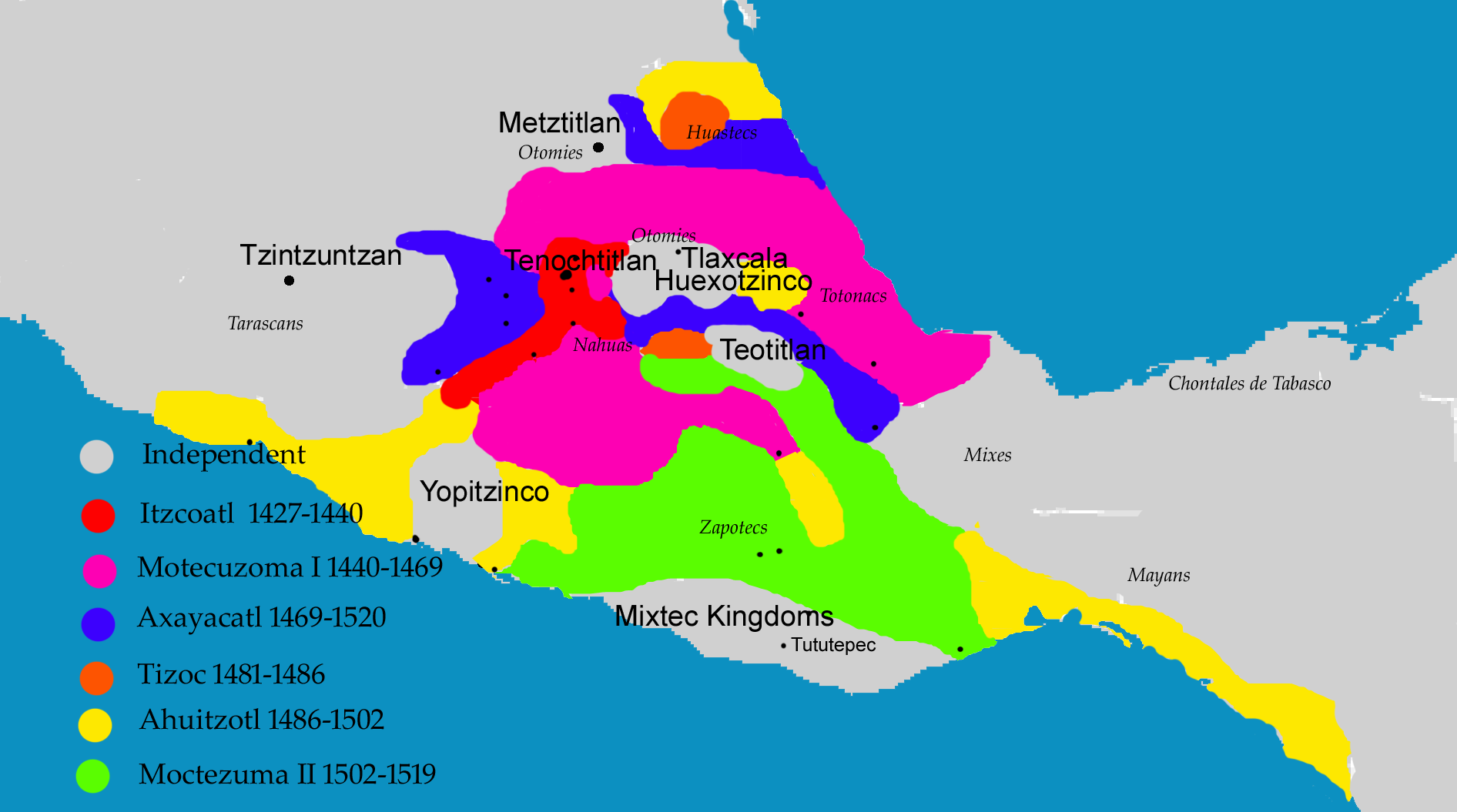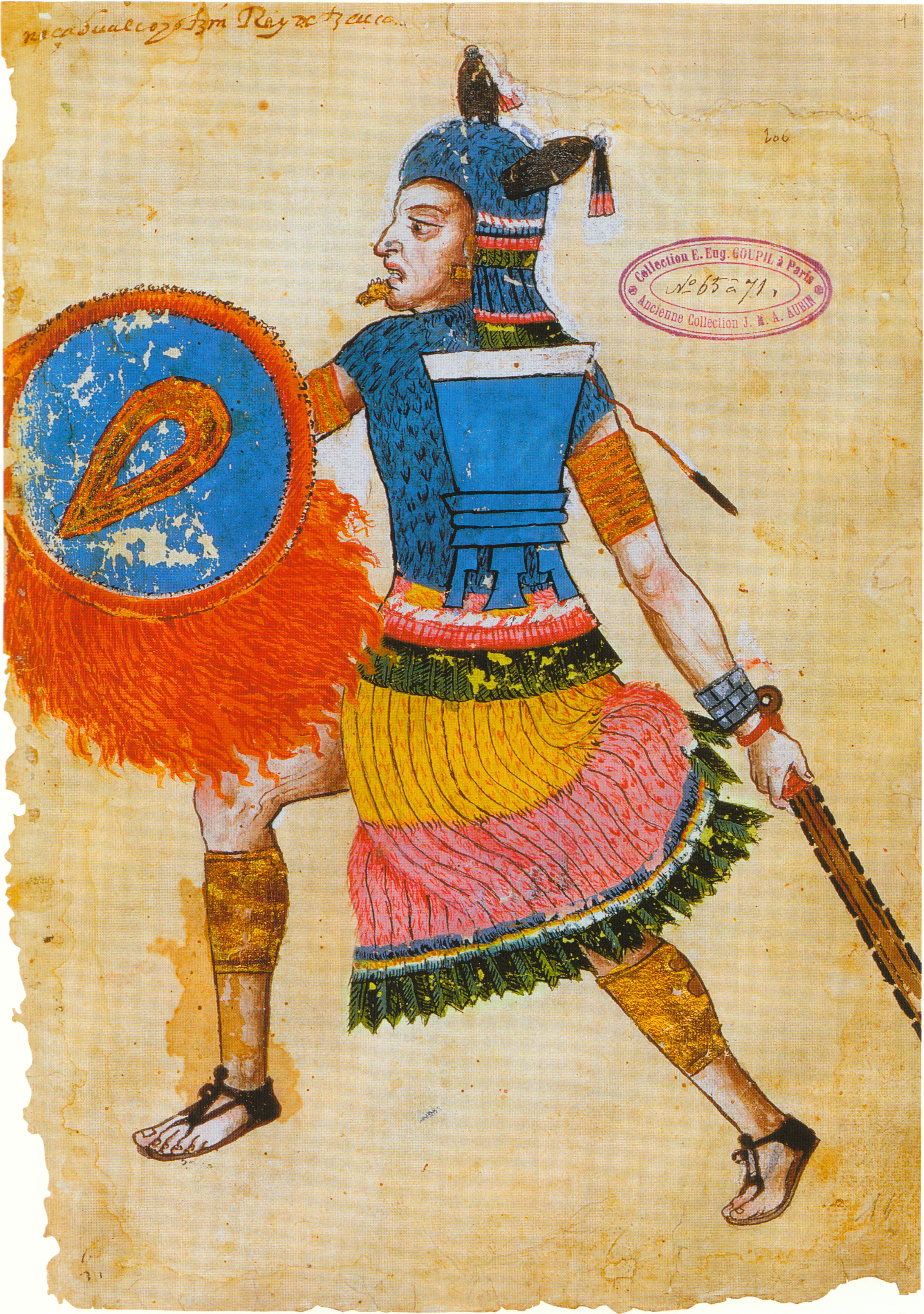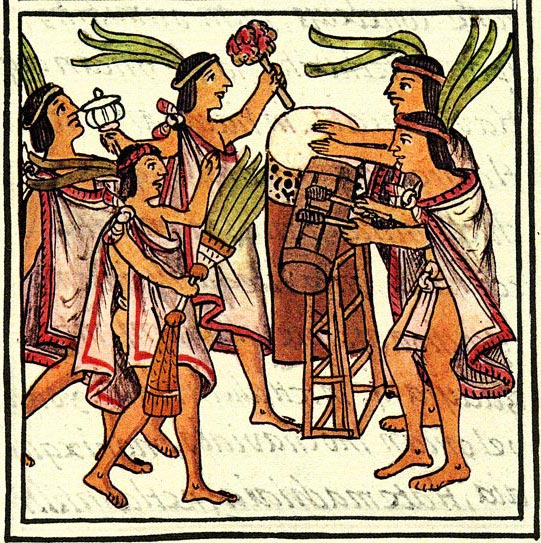|
Tochihuitzin Coyolchiuhqui
Tochihuitzin, son of Itzcoatl, was ruler of Teotlatzinco. Tochihuitzin and his brothers helped save Nezahualcoyotl from being captured by the Azcapotzalca that Nezahualcoyotl found refuge with the Mexica. According to Cronica Mexicayotl, Tochihuitzin married Achihuapoltzin, daughter of Tlacaelel Tlacaelel I (1397 – 1487) ( nci, Tlācaēllel , "Man of Strong Emotions," from "tlācatl," person and "ēllelli," strong emotion) was the principal architect of the Aztec Triple Alliance and hence the Mexica (Aztec) empire. He was the son .... After the battle against the city of Azcapotzalco, Tochihuitzin became ruler of Teotlatzinco. Poetry He would be remembered as a poet. His poems mostly focused on the meaning of life. Poems attributed to Tochihuitzin include: *Zan Tontemiquico (We Come Only To Dream) *Cuicatl Anyolque (You Have Lived The Song) References * {{DEFAULTSORT:Coyolchiuhqui, Tochihuitzin Nahuatl-language poets Place of birth unknown Place of death unkn ... [...More Info...] [...Related Items...] OR: [Wikipedia] [Google] [Baidu] |
Itzcoatl
Itzcoatl ( nci-IPA, Itzcōhuātl, it͡sˈkoːwaːt͡ɬ, "Obsidian Serpent", ) (1380–1440) was the fourth king of Tenochtitlan, and the founder of the Aztec Empire, ruling from 1427 to 1440. Under Itzcoatl the Mexica of Tenochtitlan threw off the domination of the Tepanecs and established the Triple Alliance (Aztec Empire) together with the other city-states Tetzcoco and Tlacopan. Biography Itzcoatl was the natural son of ''tlàtoāni'' Acamapichtli and an unknown Tepanec woman from Azcapotzalco. He was elected as the king when his predecessor, his nephew Chimalpopoca, was killed by Maxtla of the nearby Tepanec ''āltepētl'' (city-state) of Azcapotzalco. Allying with Nezahualcoyotl of Texcoco, Itzcoatl went on to defeat Maxtla and end the Tepanec domination of central Mexico. After this victory, Itzcoatl, Nezahualcoyotl, and Totoquilhuaztli, king of Tlacopan, forged what would become known as the Aztec Triple Alliance, forming the basis of the eventual Aztec Empire. ... [...More Info...] [...Related Items...] OR: [Wikipedia] [Google] [Baidu] |
Nezahualcoyotl (tlatoani)
Nezahualcoyotl ( nci, Nezahualcoyōtl , ) (April 28, 1402 – June 4, 1472) was a scholar, philosopher (tlamatini), warrior, architect, poet and ruler (''tlatoani'') of the city-state of Texcoco (altepetl), Texcoco in pre-Columbian era Mexico. Unlike other high-profile Mexican figures from the century preceding Spanish conquest of the Aztec Empire, Nezahualcoyotl was not fully Mexica; his father's people were the Acolhua, another Nahuan people settled in the eastern part of the Valley of Mexico, on the coast of Lake Texcoco. His mother, however, was the sister of Chimalpopoca, the Mexica king of Tenochtitlan. He is best remembered for his poetry, but according to accounts by his descendants and biographers, Fernando de Alva Cortés Ixtlilxóchitl and Juan Bautista Pomar, he had an experience of an "Unknown, Unknowable Lord of Everywhere" to whom he built an entirely empty temple in which no blood sacrifices of any kind were allowed — not even those of animals. However, he allowed ... [...More Info...] [...Related Items...] OR: [Wikipedia] [Google] [Baidu] |
Mexica
The Mexica (Nahuatl: , ;''Nahuatl Dictionary.'' (1990). Wired Humanities Project. University of Oregon. Retrieved August 29, 2012, frolink/ref> singular ) were a Nahuatl-speaking indigenous people of the Valley of Mexico who were the rulers of the Aztec Empire. The Mexica established Tenochtitlan, a settlement on an island in Lake Texcoco, in 1325. A dissident group in Tenochtitlan separated and founded the settlement of Tlatelolco with its own dynastic lineage. In 1521, they were conquered by an alliance of Spanish conquistadors and indigenous people including the Tlaxcaltecs led by Hernán Cortés. Names The ''Mexica'' are eponymous of the place name Mexico (''Mēxihco'' ), originally referring to the interconnected settlements in the valley that is now Mexico City. The group was also known as the Culhua-Mexica in recognition of its kinship alliance with the neighboring Culhua, descendants of the revered Toltecs, who occupied the Toltec capital of Tula from the 1 ... [...More Info...] [...Related Items...] OR: [Wikipedia] [Google] [Baidu] |
Cronica Mexicayotl
The ''Nuova Cronica'' (also: ''Nova Cronica'') or ''New Chronicles'' is a 14th-century history of Florence created in a year-by-year linear format and written by the Italian banker and official Giovanni Villani (c. 1276 or 1280–1348). The idea came to him after attending the first Jubilee in the city of Rome, in 1300, where he realized that Rome's many historical achievements were well-known, and he desired to lay out a history of the origins of his own city of Florence.Bartlett, 36. In his ''Cronica'', Villani described in detail the many building projects of the city, statistical information on population, ordinances, commerce and trade, education, and religious facilities. He also described several disasters such as famines, floods, fires, and the pandemic of the Black Death in 1348, which would take his own life.Benedictow, 69. Villani's work on the ''Nuova Cronica'' was continued by his brother Matteo (from April 1348 until July 1363) and his nephew Filippo (u ... [...More Info...] [...Related Items...] OR: [Wikipedia] [Google] [Baidu] |
Tlacaelel
Tlacaelel I (1397 – 1487) ( nci, Tlācaēllel , "Man of Strong Emotions," from "tlācatl," person and "ēllelli," strong emotion) was the principal architect of the Aztec Triple Alliance and hence the Mexica (Aztec) empire. He was the son of Emperor Huitzilihuitl and Queen Cacamacihuatl, nephew of Emperor Itzcoatl, father of poet Macuilxochitzin, and brother of Emperors Chimalpopoca and Moctezuma I. During the reign of his uncle Itzcoatl, Tlacaelel was given the office of Tlacochcalcatl, but during the war against the Tepanecs in the late 1420s, he was promoted to first adviser to the ruler, a position called '' Cihuacoatl'' in Nahuatl, an office that Tlacaelel held during the reigns of four consecutive ''Tlatoque'', until his death in 1487. Tlacaelel recast or strengthened the concept of the Aztecs as a chosen people, elevated the tribal god/hero Huitzilopochtli to top of the pantheon of gods, and increased militarism. In tandem with this, Tlacaelel is said to ha ... [...More Info...] [...Related Items...] OR: [Wikipedia] [Google] [Baidu] |
Place Of Birth Unknown
Place may refer to: Geography * Place (United States Census Bureau), defined as any concentration of population ** Census-designated place, a populated area lacking its own municipal government * "Place", a type of street or road name ** Often implies a dead end (street) or cul-de-sac * Place, based on the Cornish word "plas" meaning mansion * Place, a populated place, an area of human settlement ** Incorporated place (see municipal corporation), a populated area with its own municipal government * Location (geography), an area with definite or indefinite boundaries or a portion of space which has a name in an area Placenames * Placé, a commune in Pays de la Loire, Paris, France * Plače, a small settlement in Slovenia * Place (Mysia), a town of ancient Mysia, Anatolia, now in Turkey * Place, New Hampshire, a location in the United States * Place House, a 16th-century mansion largely remodelled in the 19th century, in Fowey, Cornwall * Place House, a 19th-century mansion ... [...More Info...] [...Related Items...] OR: [Wikipedia] [Google] [Baidu] |
Place Of Death Unknown
Place may refer to: Geography * Place (United States Census Bureau), defined as any concentration of population ** Census-designated place, a populated area lacking its own municipal government * "Place", a type of street or road name ** Often implies a dead end (street) or cul-de-sac * Place, based on the Cornish word "plas" meaning mansion * Place, a populated place, an area of human settlement ** Incorporated place (see municipal corporation), a populated area with its own municipal government * Location (geography), an area with definite or indefinite boundaries or a portion of space which has a name in an area Placenames * Placé, a commune in Pays de la Loire, Paris, France * Plače, a small settlement in Slovenia * Place (Mysia), a town of ancient Mysia, Anatolia, now in Turkey * Place, New Hampshire, a location in the United States * Place House, a 16th-century mansion largely remodelled in the 19th century, in Fowey, Cornwall * Place House, a 19th-century mansion ... [...More Info...] [...Related Items...] OR: [Wikipedia] [Google] [Baidu] |
14th-century Births
As a means of recording the passage of time, the 14th century was a century lasting from 1 January 1301 (Roman numerals, MCCCI), to 31 December 1400 (Roman numerals, MCD). It is estimated that the century witnessed the death of more than 45 million lives from political and natural disasters in both Europe and the Mongol Empire. West Africa experienced economic growth and prosperity. In History of Europe, Europe, the Black Death claimed 25 million lives wiping out one third of the European population while the Kingdom of England and the Kingdom of France fought in the protracted Hundred Years' War after the death of Charles IV of France, Charles IV, King of France led to a claim to the French throne by Edward III of England, Edward III, King of England. This period is considered the height of chivalry and marks the beginning of strong separate identities for both England and France as well as the foundation of the Italian Renaissance and Ottoman Empire. In History of Asia, Asia, ... [...More Info...] [...Related Items...] OR: [Wikipedia] [Google] [Baidu] |




